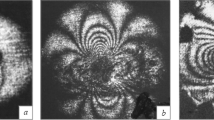Abstract
The residual stress due to welding in steel and alloy structures is analyzed. The greatest residual stress is produced by cooling of the welded structure. The results of calculations are in satisfactory agreement with the experimental deformation of the structure in welding on a test bench. The tests reveal the direction of the internal stress and permit assessment of the geometry of parts on the basis of a model of the temperature fields in the butt welding of steel and titanium-alloy workpieces. A coercimeter may be used to assess the stress state of the material and its defect content. By that means, it is possible to predict the structural state and properties of weld joints. The dynamics of welding deformation may be understood on the basis of the internal residual stress and the structural transformations produced by the welding process.
Similar content being viewed by others
References
Vinokurova, V.A. and Grigor’yants, A.G., Teoriya svarochnykh deformatsii i napryazhenii (Theory of Welding Deformations and Tensions), Moscow: Mashinostroenie, 1984.
Russo, V.L., Dugovaya svarka v inertnykh gazakh (Arc Welding in Inert Gases), Leningrad: Sudostroenie, 1984.
Gurevich, S.M., Zamkov, V.N., Blashchuk, V.E., et al., Metallurgiya i tekhnologiya svarki titana i ego splavov (Metallurgy and Technology of Welding of Titanium and Its Alloys), Kiev: Naukova Dumka, 1986.
Tarasov, A.A., Matokhin, G.V., and Molokov, K.A., Distribution of temperature fields and their influence on structural parameters of materials for welding, in Issledovaniya po voprosam povysheniya effektivnosti sudostroeniya i soudremonta (Research on Efficiency Improvement of Shipbuilding and Ship Repair), Vladivostok: Dal’nevost. Gos. Tekh. Univ., 2005.
Karpov, L.P., Profilaktika razrushenii i novye tekhnologii termoobrabotki (Prevention of Destruction and New Heat Treatment Technologies), Moscow: Mashinostroenie, 2003.
Potak, Ya.M., Khrupkie razrusheniya stalei i stal’nykh izdelii (Brittle Fractures of Steels and Steel Products), Moscow: Mashinostroenie, 1965.
Sizov, A.M. and Vorob’ev, G.A., The effect of pulse treatment on internal tensions in steel, Perspekt. Mater., 1997, no. 4, pp. 67–71.
Debelyak, A.A., Murav’ev, V.I., and Bakhmatov, P.V., Kinetics of deformation processes during welding of carbon steel billets, in Mater. Ross. nauchno-tekh. konf. “Fundamental’nye issledovaniya v oblasti tekhnologii dvoinogo naznacheniya,” Komsomol’sk-na-Amure, 21-24 noyabrya 2011 g. (Proc. Russ. Sci.-Tech. Conf. “Fundamental Research of Dual-Purpose Technologies,” Komsomolsk-on-Amur, November 21–24, 2011), Komsomolsk-on-Amur: Komsomol’sk-na-Amure Gos. Tekh. Univ., 2011.
Debelyak, A.A., Murav’ev, V.I., and Bakhmatov, P.V., Possible calculation of the residual deformations using thermal fields during line-on-line welding of thin plates, Uch. Zap. Komsomol’sk-na-Amure Gos. Tekh. Univ., 2010, no. 1 (4), pp. 68–70.
Waschull, H., Präparative Metallographie: Präparationstechnik für die Lichtmikroskopie, Weinheim: Wiley, 1993.
Brandon, D.G. and Kaplan, W.D., Microstructural Characterization of Materials, New York: Wiley, 2008, 2nd ed.
Shpileva, A.A., Development of quantitative structural-energetic parameters of microstructure of polycrystalline materials, Extended Abstract of Cand. Sci. (Tech.) Dissertation, Komsomolsk-on-Amur: Komsomol’sk-na-Amure Gos. Tekh. Univ., 2009.
Kolmakov, A.G., Terent’ev, V.F., and Bakirov, M.B., Metody izmereniya tverdosti (Methods for Solidity Measurement), Moscow: Intermet Inzhiniring, 2005.
Nikitenko, B.F., Kazakov, N.S., and Kuznetsov, V.P., Puti povysheniya dostovernosti i tochnosti analiza emissionnoi spektrografii (The Methods of Improvement of Reliability and Accuracy of Emission Spectrographic Analysis), Moscow: Tsentr. Nauchno-Issled. Inst. Inf. Tekh.-Ekon. Issled., 1989.
Cherepovskii, P.V. and Murav’ev, V.I., Efficiency of removal of residual tensions in welded titanium alloys, in Mater. III nauchno-prakt. konf. molodykh uchenykh i aspirantov “Issledovaniya i perspektivnye razrabotki v aviatsionnoi promyshlennosti,” Moskva, 23–25 noyabrya 2005 g. (Proc. III Sci.-Pract. Conf. of Young Scientists and Postgraduate Students “Research and Prospective Developments in Aviation Industry,” Moscow, November 23–25, 2005), Moscow: OKB Sukhogo, 2005, pp. 510–515.
Author information
Authors and Affiliations
Corresponding author
Additional information
Original Russian Text © V.I. Murav’ev, P.V. Bakhmatov, N.O. Pletnev, A.A. Debelyak, 2016, published in Izvestiya VUZ. Chernaya Metallurgiya, 2016, No. 4, pp. 251–255.
About this article
Cite this article
Murav’ev, V.I., Bakhmatov, P.V., Pletnev, N.O. et al. Influence of the stress state on the structure and properties of welded steel and alloy structures. Steel Transl. 46, 256–259 (2016). https://doi.org/10.3103/S0967091216040070
Received:
Published:
Issue Date:
DOI: https://doi.org/10.3103/S0967091216040070




